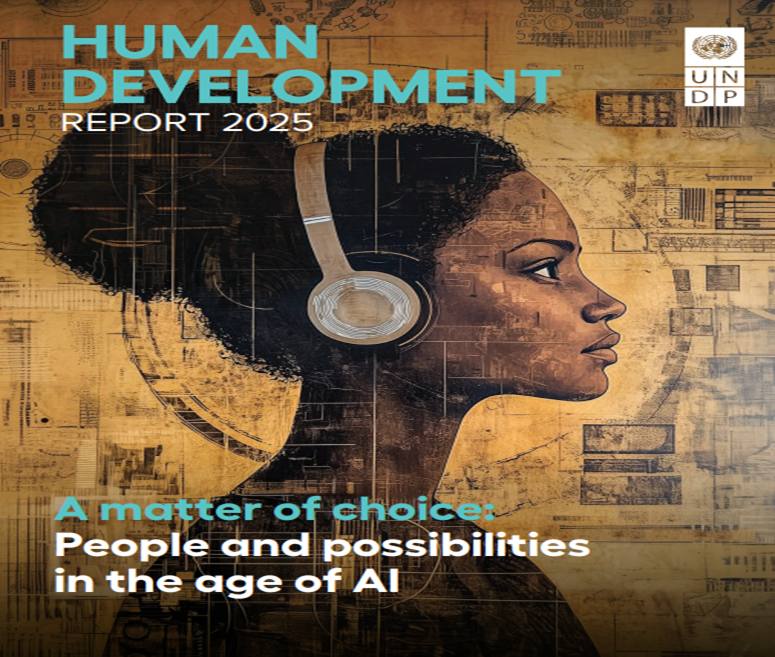The 2025 Human Development Report (HDR) has been released. Whereas the interest of many who look forward to this report has always been the Human Development Index (HDI), which is a summary measure of average achievement in key dimensions of human development: a long and healthy life, being knowledgeable and having a decent standard of living; it is important to take a deep dive into the rich literature underlining the rankings. The 2025 report seems to have anchored on the third dimension of human development. Coming with the subtitle – “A matter of choice: People and possibilities in the age of AI” – the report across its 6 chapters and 311 pages made commendable progress in establishing an indubitable nexus between being knowledgeable and the future of human lives. Taking a technological viewpoint, the 2025 HDR is simply pointing the global leaders to a sustainable path to human development where being knowledgeable (AI) can help solve the most pressing global needs (People) and also provide good leverage for more economic prosperity (Possibilities); success or failure, action or inaction towards this pursuit is a matter of choice. Whilst many would expect the regular themes around climate change, crime, poverty, political instability, out-of-school children, hunger and starvation, diseases and wars; the editorial team took a different turn pointing the audience to a new-found path where all of these global issues would begin to diminish when confronted with the right solutions powered by AI. The 2025 HDR reminds us ‘that it is people, not machines, who determine which technologies thrive, how they are used and whom they serve. AI’s impact will be defined not by what it can do but by the decisions we make in its design, development and deployment’. In the foreword to the 2025 HDR, Achim Steiner (UNDP Administrator) wrote: “Artificial intelligence (AI) is racing ahead at lightning speed. Yet as AI surges forward, human development stalls. Decades of progress, reflected in the Human Development Index, have flatlined, with no clear recovery from the blows dealt by the Covid-19 pandemic and subsequent crises. We are at a crossroads: while AI promises to redefine our future, it also risks deepening the divides of a world already off balance. Are we on the verge of an AI-powered renaissance—or sleepwalking into a future ruled by inequality and eroded freedoms? Too often, headlines, policies and public debates fixate on what AI might achieve in some distant future—utopian or dystopian. These deterministic views are not only disempowering; they are profoundly misleading. They obscure the fact that the future is being shaped now, by the choices we make today”.

The Future and the Balance
Each of the 6 chapters of the report provides more illumination on the path to making the right choices in developing the people of the earth and empowering them to maximize opportunities as they present. Setting out the first chapter with focus on empowering people to make artificial intelligence work for human development, the message is that attention should not only be on just those who build AI but also how people everywhere can use AI to improve their lives. The chapter challenges unhelpful myths about AI replicating humans and calls for reimagining the relationship between people and this powerful new technology. Despite all the things that AI can do, the chapter re-emphasizes that it cannot replace human judgement. Therefore, thinking beyond replacing humans reveals opportunities for AI to augment human development and enhance the unique contributions of human intelligence, including expanding human scientific and expressive creativity.
The second chapter reinforces the submissions made in the succeeding chapter coming with more action in its theme, “From tools to agents: Rewiring artificial intelligence to promote human development”. The message is that of achieving balance between automation and human development: as AI becomes integrated into our world, it raises the possibility of automating tedious decisions alongside the danger of inadvertently ceding human agency; a specter whose consequences will not only be felt by individuals in moments but through cumulative consequences for collectives and cultures. The chapter concludes that averting loss of human agency to machines requires going beyond a quest for more agentic models and instead favouring development of AI that expands, rather than contracts, human choice and freedom. In the third chapter, the report re-echoed, “Artificial intelligence across life stages: Insights from a people-centered perspective”. Still talking people, here the message is that differences in frequency and purpose of use shape the ways in which AI affects people’s lives. Hence the life-stage perspective throws up three policy imperatives otherwise referred to as the three I’s of advancing human development – Invest (in power, internet, digital devices and skills); Inform (educate people on risks and opportunities); Include (include people of all ages, gender, ethnicities and backgrounds in AI design and development).

The Choices We Must Make Today
In Steiner’s submission, the 2025 Human Development Report on AI is not about technology, it is about people, and our ability to reinvent ourselves in the face of profound change. Self-reinvention in the face of change is a necessity, yet a choice. Framing narratives to reimagine artificial intelligence to advance human development is the theme of the fourth chapter whose central focus is a re- orientation from the techno-determinist narrative that assumes that AI alone will either solve all our problems or threaten the future of humanity, to the reality that institutional and social choices made today can enable AI to expand people’s capabilities and overcome inherent limitations. This has been demonstrated in the use of AI in managing disabilities and improving healthcare systems.
Power, influence and choice in the Algorithmic Age is another critical issue under focus in the 2025 HDR, with special attention on the supply side of AI. Addressing this issue in the fifth chapter, key questions bordering on choice include: what kinds of AI tools are developed, by whom and for what purpose? The chapter examines “power over” people: how AI producers and sometimes AI itself can affect people’s prospects (in positive and negative ways), alter their options (the choices they can exercise) or influence their beliefs and preferences (including what they value and have reason to value). A better way to answer this question is encapsulated in the theme of the last chapter – “Reimagining choices: Towards artificial intelligence-augmented human development”. This theme embodies an actionable framework comprising three policy directions, namely: building a complementarity economy; driving innovation with intent and investing in capabilities that count. For nations that want to improve their Human Development Index, this three-pronged policy direction aims to inspire context-specific choices that would help them harness AI to expand opportunities, enhance people’s capabilities and deliver improvements in people’s lives.

About the Report
The Human Development Report (HDR) is an annual Human Development Index report published by the Human Development Report Office of the United Nations Development Programme (UNDP). The first HDR was launched in 1990 with the sole aim of placing people at the center of the development process in terms of economic debate, policy and advocacy. Since then, reports have been released exploring different themes through the human development approach which places people at the center of the development process. The reports are ensured of editorial independence by the United Nations General Assembly; thus, they are seen as reports to UNDP, not of UNDP. This allows each report greater freedom to explore ideas and constructively challenge policies. Each report also presents an updated set of indices, including the Human Development Index (HDI), which is a measure of average achievement in the basic dimensions of human development across countries, and a compendium of key development statistics relevant to the report theme. The UN General Assembly has formally recognized the Report as “an independent intellectual exercise” and “an important tool for raising awareness about human development around the world.” HDR is translated into numerous languages and launched in more than 100 countries annually. Download full report here: https://bit.ly/43jYAXY.

The CSR Arena is a CSR advocacy and sustainability-reporting-analysis champion. We encourage and celebrate effective CSR and positive social impact by responsible corporate citizens; we celebrate international best practices in sustainability reporting across different economic divides. Our goal is to realize the dream of development scholars that, ‘corporates, more than governments, would bring about the much needed sustainable development across the globe. We partner with FBOs, NGOs, CBOs, governments and corporates to spread the message of sustainable development and corporate sustainability. Our platforms bear tales of good corporate citizenship – grab the microphone that you may be heard. Contact: news@thecsrarena.com



